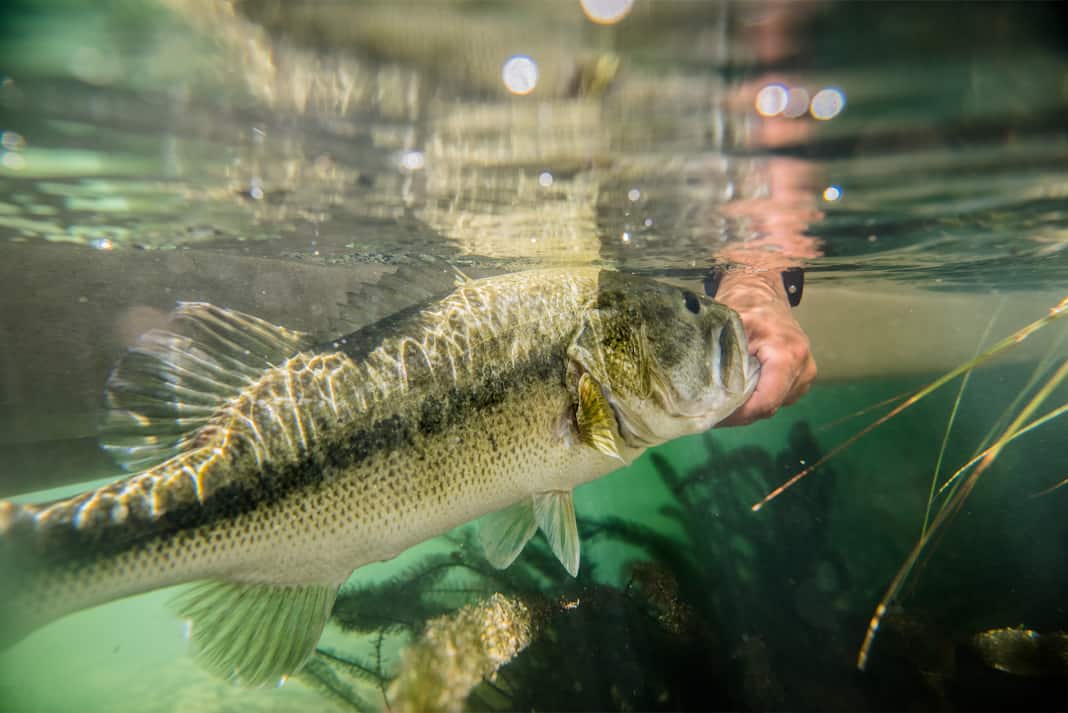I love to fish, and I am guessing since you are reading this, you do too. Part of fishing is taking responsibility for caring for both the fish and the fishery. As anglers, it is our obligation to reduce stress and injury to bass during tournaments as well as pleasure fishing. Understanding and implementing a few strategies goes a long way toward promoting the health of the fish and preserving the waters where they live. Here are some principles to help you become a more responsible angler.
How a Responsible Angler Can Protect the Fish
Minimize Air Exposure
A quick biology lesson – bass rely on their gills to obtain oxygen from water. Without a constant flow of water over their gills, bass are unable to extract enough oxygen for their metabolic needs. This can lead to suffocation, oxygen deprivation, and potentially severe stress and organ damage.
Additionally, the protective mucus layer, slime coat, on a bass’s skin protects it from disease, along with several other functions. When a bass is exposed to air, this mucus layer quickly dries out, making the fish susceptible to infections, parasites, and other external stressors. Improper handling or contact with dry surfaces can also cause damage or displacement of the bass’s scales.
Lastly, the risk of physical injury increases the longer a bass is out of water. Bass are not designed to bear their own weight for extended periods, particularly without the buoyancy and support provided by water. Flopping on dry surfaces or mishandling can lead to internal injuries, fractures, and significant stress, which can have a harmful impact on the bass’s overall health and survival chances upon release.
Keep fish in the water as much as possible and avoid excessively handling or dropping them on dry surfaces. If a fish needs to be removed from the water for measuring or photographs, do so quickly and gently, ensuring the fish is supported horizontally.
Use Appropriate Landing Nets
Choose landing nets made of soft, knotless mesh to minimize damage to fish. Avoid using nets with abrasive surfaces or small mesh sizes that can harm the fish’s delicate scales and fins. Wet the net before use to reduce friction and minimize stress. Once the fish is in the net, do not lift the fish solely by the net handle. Instead, support the fish’s weight by cradling the net with your hand or holding the fish from underneath its body. Be sure that the net is large enough to comfortably accommodate the size of the fish you’re targeting. A net that is too small can cause unnecessary stress and potential injury to the fish.
Wet Your Hands
Wetting your hands before handling bass helps protect their slime coat, which acts as a defense against infection and disease. Dry hands or hands coated in sunscreen or lotions can remove the slime and harm the fish. Wet your hands or wear wet gloves when handling fish.
Use Proper Gripping Techniques
When handling bass, avoid squeezing or applying excessive pressure to their body. Instead, support them firmly but gently. Place one hand under the fish’s belly and support the weight with your other hand, allowing the fish to remain horizontal.
Unhook Efficiently
Use appropriate tools, such as long-nose pliers or hemostats, to quickly and efficiently remove hooks. Minimize handling time and keep the fish in the water whenever possible. If a fish is deeply hooked or the hook is difficult to remove, consider cutting the line near the hook instead of causing further injury.
Revive Fish Properly
If a bass appears sluggish or exhausted after being caught, take the time to revive it before releasing it. Hold the fish upright in the water, gently supporting it by the belly, and allow it to regain its strength. Move the fish in a figure-eight pattern to help water flow through the gills, ensuring proper oxygenation. Fish don’t swim backward, so don’t move the fish back and forth.
Consider Livewell Conditions
If you’re using a livewell, ensure it is properly aerated and the water temperature is suitable for bass. Monitor water quality, including oxygen levels and ammonia concentrations, and make adjustments as needed. Avoid overcrowding the livewell to prevent stress and injuries from fish colliding with each other.
And Protect the Fishery
Line
Be careful with your fishing line. Improperly discarded fishing line can harm the environment and wildlife. It does not break down naturally and can entangle and trap animals and other fish. Proper disposal is essential to reduce these risks. Keep a specific container in your boat, like a ziplock bag to store old line. Whenever possible, find a line recycling station to properly dispose of your line. If your favorite ramp doesn’t already have line recycling, consider volunteering to create one. BoatUS and Berkley offer programs.
Trash
It almost goes without saying but be careful with your trash. In Lake Lanier alone, 140,000 pounds of trash is cleaned out annually. Typically, bass anglers are a very low percentage of this number but be aware of wrappers and water bottles so they do not accidentally blow out of your boat. Continue to be a responsible angler, by securing your trash while on the water.
Habitats
Be mindful of habitat destruction. Avoid damaging sensitive aquatic habitats, such as vegetation beds, submerged structures, or spawning areas. These habitats are crucial for the survival and reproduction of bass and other aquatic species. I am sure, as a responsible angler, you know this, but it is worth repeating.
It is important for us to take care of the fish and the fishery. We all have a shared responsibility to actively reduce stress and injury to bass during tournaments and pleasure fishing. At the same time, we must protect the waters we fish in. Implementing these practices will go a long way in taking care of both, and continue your quest to be a responsible angler.
Feature photo: Dustin Doskocil kayakanglermag.com


Recent Comments